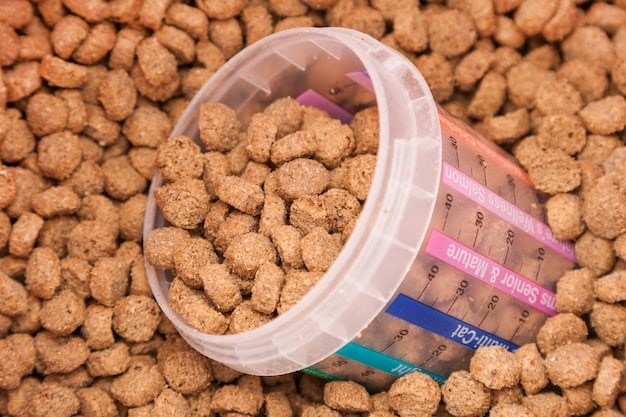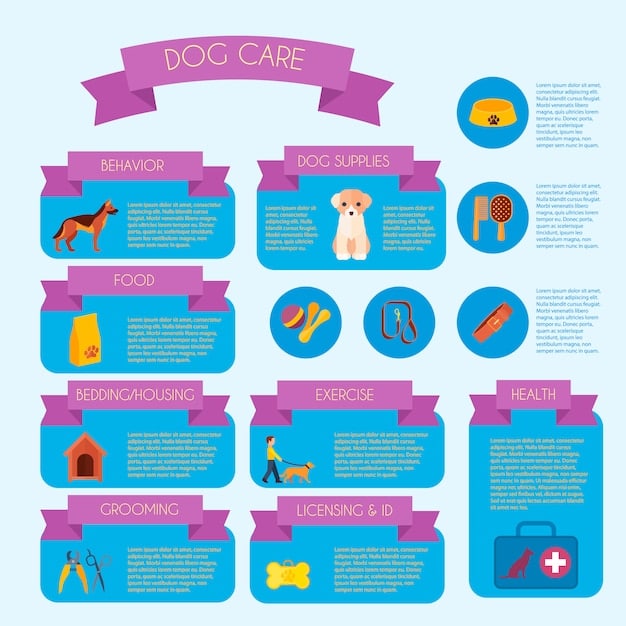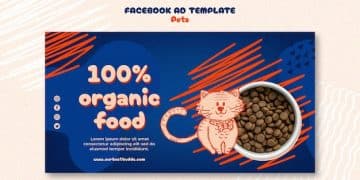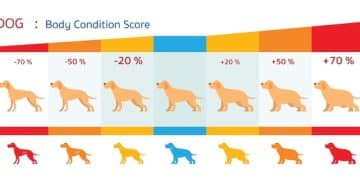Decoding Pet Food Labels: Understanding Guaranteed Analysis for Pet Health

Anúncios
Decoding Pet Food Labels: What the Guaranteed Analysis REALLY Means for Your Pet’s Health involves understanding the percentages of crude protein, fat, fiber, and moisture to ensure your pet receives adequate nutrition for their specific needs and life stage.
Deciphering pet food labels can feel like navigating a complex code. However, understanding the **Decoding Pet Food Labels: What the Guaranteed Analysis REALLY Means for Your Pet’s Health** is vital for ensuring your beloved companion receives the nutrition they need to thrive.
Anúncios
Understanding the Basics of Pet Food Labels
Pet food labels contain a wealth of information, but they can be overwhelming. Understanding the key components is the first step to making informed decisions about your pet’s diet. Let’s break down the essential elements of a pet food label.
Key Components of a Pet Food Label
Pet food labels are regulated by the Food and Drug Administration (FDA) and often guided by the Association of American Feed Control Officials (AAFCO). They are designed to provide consumers with essential information about the product.
Anúncios
- Product Name: Indicates the main ingredients and their percentages in the food.
- Guaranteed Analysis: States the minimum or maximum levels of certain nutrients, such as protein, fat, fiber, and moisture.
- Ingredient List: Lists the ingredients in descending order by weight.
- Nutritional Adequacy Statement: Verifies that the food meets the nutritional levels established by AAFCO, indicating for which life stage the food is suitable.
- Feeding Guidelines: Provides recommendations for how much food to give your pet based on their weight and activity level.
The guaranteed analysis is often the most scrutinized part of the label because it directly reflects the nutritional composition of the food. Knowing how to interpret these values allows you to assess the quality and suitability of the food for your pet’s specific needs.
What is Guaranteed Analysis?
The guaranteed analysis is a listing of the minimum and maximum percentages of specific nutrients present in pet food. It’s a crucial tool for evaluating the nutritional content but requires some understanding to be used effectively.

Decoding the Key Nutrients
Four primary components always appear in the guaranteed analysis: crude protein, crude fat, crude fiber, and moisture. Understanding what each of these represents is essential.
- Crude Protein (Minimum %): Refers to the total amount of protein in the food, including both digestible and indigestible protein. Higher percentages generally suggest a food that can support muscle development and overall health.
- Crude Fat (Minimum %): Indicates the total amount of fat, necessary for energy and the absorption of fat-soluble vitamins. Different fat sources can impact the quality and benefits of the food.
- Crude Fiber (Maximum %): Represents the total amount of indigestible plant matter. While some fiber is important for digestive health, high levels can reduce the digestibility of other nutrients.
- Moisture (Maximum %): Defines the water content in the food, which affects the dry matter content and overall freshness of the product.
Beyond these four, some labels also include guarantees for other nutrients like ash, taurine, and omega fatty acids. Each nutrient plays a crucial role in your pet’s health, so it’s important to consider the entire profile when evaluating a pet food.
Crude Protein: More Than Just a Number
Proteins are the building blocks of life, essential for muscle development, immune function, and overall vitality. However, not all protein sources are created equal, and the guaranteed analysis only tells part of the story.
Sources and Quality of Protein
The source of protein is just as important as the percentage. High-quality protein sources are more digestible and provide a better amino acid profile.
Plant-based proteins such as soy and corn can contribute to the crude protein percentage but may not offer the same benefits as animal-based proteins like chicken, beef, or fish. Look for named animal protein sources at the top of the ingredient list for a better-quality food.
The digestibility of a protein source refers to how much of the protein your pet can actually use. Highly digestible proteins provide more amino acids, supporting optimal health and wellbeing.
Calculating Protein on a Dry Matter Basis
To accurately compare the protein content across different types of pet food (dry vs. wet), you need to calculate the protein content on a dry matter basis. This removes the influence of moisture content.
To calculate the dry matter protein percentage, use the following formula:
Dry Matter Protein % = (Crude Protein % / (100 – Moisture %)) x 100
For example, if a wet food has 10% crude protein and 75% moisture, the dry matter protein percentage is (10 / (100 – 75)) x 100 = 40%. This allows for a direct comparison with dry foods.
Understanding Crude Fat in Pet Food
Fats are essential for providing energy, supporting hormone production, and aiding in the absorption of fat-soluble vitamins. The source and type of fat can significantly impact your pet’s health.
Types of Fats and Their Benefits
Different types of fats offer different benefits. It’s crucial to understand the distinction between saturated, unsaturated, and essential fatty acids.
- Saturated Fats: Provide energy and support hormone production but should be balanced with unsaturated fats.
- Unsaturated Fats: Include monounsaturated and polyunsaturated fats, which are beneficial for heart health and overall wellbeing.
- Essential Fatty Acids: Such as omega-3 and omega-6 fatty acids, cannot be produced by your pet’s body and must be obtained through their diet. These are vital for skin health, immune function, and brain development.
Look for pet foods that specify the sources of fat, like fish oil, flaxseed, or sunflower oil, which are excellent sources of essential fatty acids.
The Role of Fat in Palatability and Satiety
Fat also plays a crucial role in making food palatable and providing a feeling of fullness. Foods with higher fat content tend to be more appealing to pets.
Adequate fat intake helps pets feel satisfied after eating, reducing the likelihood of overeating. However, it’s crucial to balance fat intake with activity levels to prevent obesity.
Be mindful of your pet’s specific needs. Active pets may require higher fat content, while less active or overweight pets may benefit from lower-fat options.
Crude Fiber: Balancing Act for Digestion
Fiber is the indigestible part of plant-based foods, and while it doesn’t provide direct nutrients, it plays a crucial role in digestive health. The guaranteed analysis lists crude fiber as a maximum percentage, as too much fiber can hinder nutrient absorption.
Benefits of Fiber for Pets
Fiber has several benefits for pets, mainly related to digestive health. It adds bulk to the stool, promoting regular bowel movements.
Fiber can help manage weight by promoting a feeling of fullness. It slows down the absorption of nutrients, helping to stabilize blood sugar levels.
Certain types of fiber, like prebiotics, support the growth of beneficial gut bacteria, promoting overall gut health.
Understanding Different Types of Fiber
Not all fiber is created equal. Soluble fiber dissolves in water and forms a gel-like substance, while insoluble fiber does not dissolve and adds bulk to the stool.
Sources of soluble fiber include beet pulp, oats, and peas, while insoluble fiber can be found in cellulose and wheat bran. A balanced mix of both is ideal for optimal digestive health.
When evaluating the crude fiber content, consider the source and the overall diet. High-quality pet foods will balance fiber with other nutrients to support overall wellbeing.

Moisture Content: Wet vs. Dry Food
The moisture content in pet food significantly affects its nutritional density and how it’s compared to other foods. Understanding this helps in making informed decisions about your pet’s diet.
Comparing Dry and Wet Food Moisture Levels
Dry food typically has a moisture content of around 10%, while wet food can have moisture levels as high as 70-80%. This means that wet food has a lower concentration of dry matter, including nutrients.
When comparing foods, always convert nutrient percentages to a dry matter basis to account for the differences in moisture content. This provides a more accurate comparison of the actual nutrient levels.
The moisture content also affects the shelf life and storage requirements of the food. Dry food generally has a longer shelf life and is easier to store, while wet food needs to be refrigerated after opening.
Hydration Benefits of Wet Food
Wet food can be particularly beneficial for pets that don’t drink enough water. The high moisture content helps to keep them hydrated, which is crucial for kidney health and overall wellbeing.
Animals with certain medical conditions, such as urinary issues or kidney disease, may benefit from a diet consisting primarily of wet food due to its hydrating properties.
Consult with your veterinarian to determine the best type of food for your pet based on their individual needs and health condition.
Putting It All Together: Choosing the Right Food
Choosing the right pet food involves considering the guaranteed analysis in conjunction with other factors, such as your pet’s age, breed, activity level, and health condition.
Assessing Your Pet’s Specific Needs
Puppies and kittens require higher levels of protein and fat to support their growth, while senior pets may need lower-calorie diets to maintain a healthy weight. Active dogs need more calories and protein than sedentary ones.
Pets with specific health conditions, such as allergies or diabetes, may require special diets with specific nutrient profiles. For example, pets with kidney disease often need lower protein and phosphorus levels.
Consult with your veterinarian to get personalized recommendations based on your pet’s individual needs. They can provide guidance on the appropriate nutrient levels and ingredient choices.
Consulting with Your Veterinarian
Veterinarians are your best resource for getting personalized recommendations about your pet’s diet. They can assess your pet’s health, identify any nutritional deficiencies, and recommend foods that meet their specific needs.
Be prepared to discuss your pet’s current diet, activity level, and any health concerns. Based on this information, your veterinarian can help you navigate the pet food aisle and choose the best option for your furry friend.
Understanding the guaranteed analysis is an essential tool in evaluating pet food, but professional guidance is always invaluable in making the best choices for your pet’s health.
| Key Point | Brief Description |
|---|---|
| 🐾 Crude Protein % | Minimum protein level for muscle and overall health. |
| 💪 Crude Fat % | Minimum fat content for energy and vitamin absorption. |
| 🌿 Crude Fiber % | Maximum fiber level for digestive health. |
| 💧 Moisture % | Maximum moisture content; affects food comparison. |
Frequently Asked Questions (FAQ)
▼
“Crude” refers to the method of testing the nutrient levels and doesn’t reflect the quality of the nutrient. It’s simply the total quantity of the nutrient measured by standardized lab procedures.
▼
To calculate dry matter basis, divide the nutrient percentage by (100 – moisture percentage) and multiply by 100. This removes the effect of moisture content, allowing for a fair comparison.
▼
The ingredient list shows the ingredients in descending order by weight. It’s crucial to ensure high-quality protein sources are listed at the top, indicating they are the primary components of the food.
▼
Yes, knowing the guaranteed analysis helps you ensure that the pet food doesn’t have ingredients that your pet is allergic to. Check the ingredient list and guaranteed analysis for potential allergens.
▼
Not necessarily. While protein is essential, the ideal amount depends on your pet’s age, activity level, and health condition. Consult your vet for the appropriate protein level for your pet.
Conclusion
Understanding **Decoding Pet Food Labels: What the Guaranteed Analysis REALLY Means for Your Pet’s Health** empowers you to make better choices for your pet’s nutrition. By considering the protein, fat, fiber, and moisture content, along with your pet’s specific needs, you can ensure they receive a diet that supports their health and wellbeing.






